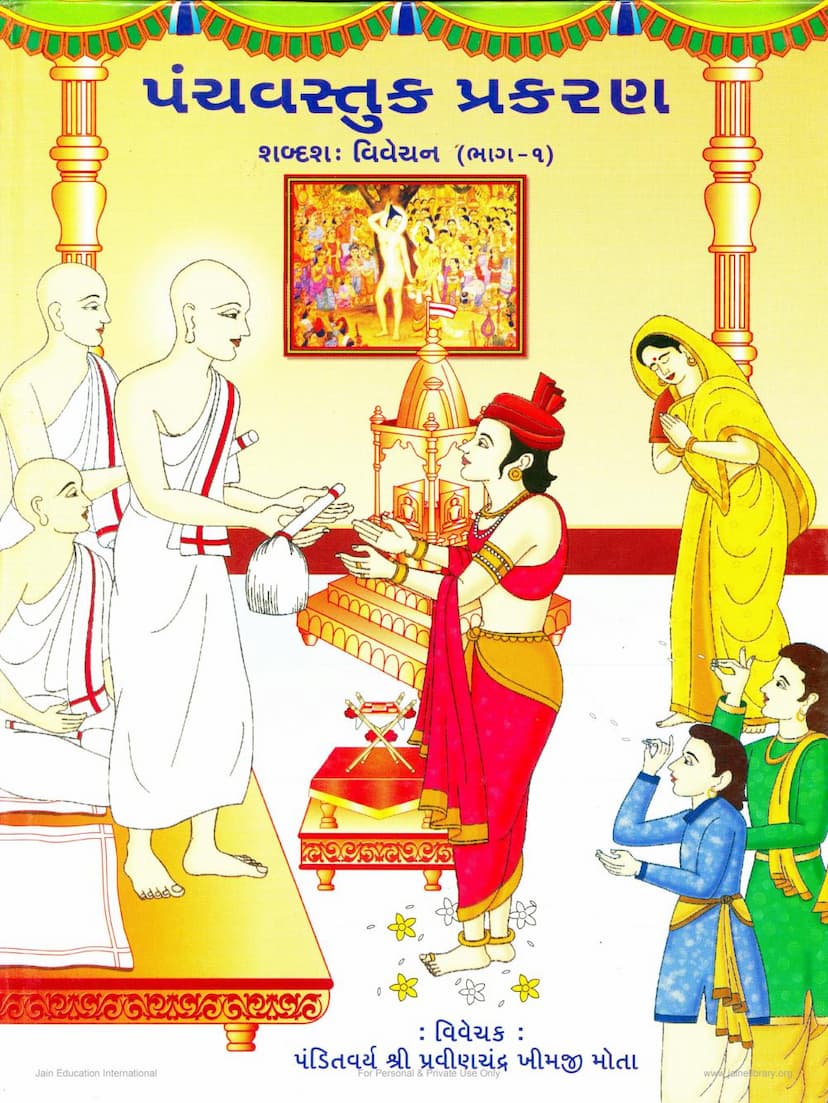Panchvastuk Prakaran Part 01
Added to library: September 2, 2025

Summary
Here is a comprehensive summary in English of the Jain text "Panchvastuk Prakaran Part 01" by Pravinchandra Khimji Mota, based on the provided Gujarati text:
Book Title: Panchvastuk Prakaran Shabdashah Vivechan (Part 01) Author: Pandit Shri Pravinchandra Khimji Mota Publisher: Gitarth Ganga Original Author/Commentator: Shri Haribhadrasuri Maharaj Subject Matter: This book is a detailed commentary (vivechan) on the "Panchvastuk" text, which itself is a commentary by the great Jain Acharya Shri Haribhadrasuri Maharaj on his own composition. The "Panchvastuk" is a significant text that outlines five essential "things" or "topics" (vastu) within Jainism, particularly focusing on the path of renunciation and spiritual practice.
Core Content and Structure:
The "Panchvastuk Prakaran" delves into five key topics relevant to spiritual aspirants, particularly monks and nuns, on their path to liberation. This commentary, "Panchvastuk Prakaran Shabdashah Vivechan (Part 01)," focuses on the first of these five topics, known as "Pravrajyavidhan Vastuk" (The Procedure of Renunciation).
The commentary is structured around the verses of Shri Haribhadrasuri Maharaj's original text, providing a word-by-word explanation. The book highlights the following key aspects:
-
The Five Topics (Panchvastu): The "Panchvastuk" treatise covers five fundamental aspects of spiritual discipline:
- Pravrajyavidhan (પ્રવ્રજ્યાવિધાન): The procedures and regulations related to taking monastic vows (renunciation).
- Pratidin Kriya (પ્રતિદિનક્રિયા): Daily activities and conduct expected of monks and nuns.
- Vrat Sthapana (વ્રતસ્થાપના): The establishment and adherence to vows.
- Anuyog GananuGna (અનુયોગ ગણાનુજ્ઞા): The permission or authority granted for teaching scriptures and managing disciples.
- Samlekhana (સંલેખના): The process of self-discipline, austerities, and eventual shedding of the body, often associated with the final stages of spiritual practice.
-
Focus of Part 01: Pravrajyavidhan: This first volume meticulously analyzes the "Pravrajyavidhan Vastuk." This section explains the intricate details of renunciation, including:
- Definition and Etymology: The meaning of "Pravrajya" is explored, signifying the departure from worldly activities to embrace the path of austerity and spiritual practice.
- The Five Doors (Dwaras) of Pravrajyavidhan: The commentary breaks down the topic of renunciation into five crucial aspects or "doors" as outlined by Haribhadrasuri:
- "Sa" (સા): The nature of Pravrajya itself, explained through four Nykshēpās (modes of understanding): Nama (name), Sthapana (establishment), Dravya (substance), and Bhava (state).
- "Kena" (કેન): Who is qualified to give Pravrajya (the Guru's qualifications)? This section details the numerous virtues and knowledge required of a Guru to initiate a disciple into renunciation, emphasizing qualities like being learned, virtuous, and compassionate.
- "Kebhyah" (કેભ્યઃ): Who is qualified to receive Pravrajya (the disciple's qualifications)? This part elaborates on the characteristics of an eligible disciple, including their background, moral conduct, detachment from worldly pleasures, and genuine desire for liberation. It also discusses the importance of age and maturity.
- "Kasmim" (કસ્મિન): In what context (place and time) should Pravrajya be given? This covers suitable and unsuitable environments and timings for renunciation.
- "Katham" (કથમ્): How should Pravrajya be administered? This delves into the rituals, inquiries, examinations, and procedures involved in the initiation ceremony.
-
Commentary Style: Pandit Pravinchandra Mota's commentary is described as "Shabdashah Vivechan," meaning a word-by-word or literal explanation. His approach aims to clarify the subtle principles and inherent meanings within the original text, making profound philosophical concepts accessible to both scholars of Sanskrit and those less familiar with the language.
-
Purpose and Benefit: The book aims to assist the Jain community in understanding the profound spiritual principles laid down by earlier Acharyas like Haribhadrasuri and Yashovijayji. It is intended to support the spiritual practice and knowledge of monks, nuns, and lay followers, ultimately guiding them towards the attainment of right faith, knowledge, and conduct, leading to ultimate liberation.
-
Supporting Figures: The publication acknowledges the blessings and guidance of prominent Jain Acharyas, including Acharyadev Shri Vijay Ramchandrasuri, Swah Paramapujya Munjitvijayji Maharaj, and Ganivarya Shri Yugbhooshanvijayji Maharaj. The compilation and research were done by Sadhvi Shri Kalpananditashriji.
Overall Significance:
"Panchvastuk Prakaran Part 01" is a scholarly work that meticulously unpacks the initial section of a vital Jain text on monastic discipline. It emphasizes the rigorous qualifications for both the teacher and the disciple in the process of renunciation, highlighting the sanctity and procedural correctness required for this significant spiritual step within Jainism. The commentary aims to provide a clear and comprehensive understanding of these ancient teachings for the benefit of the Jain community.